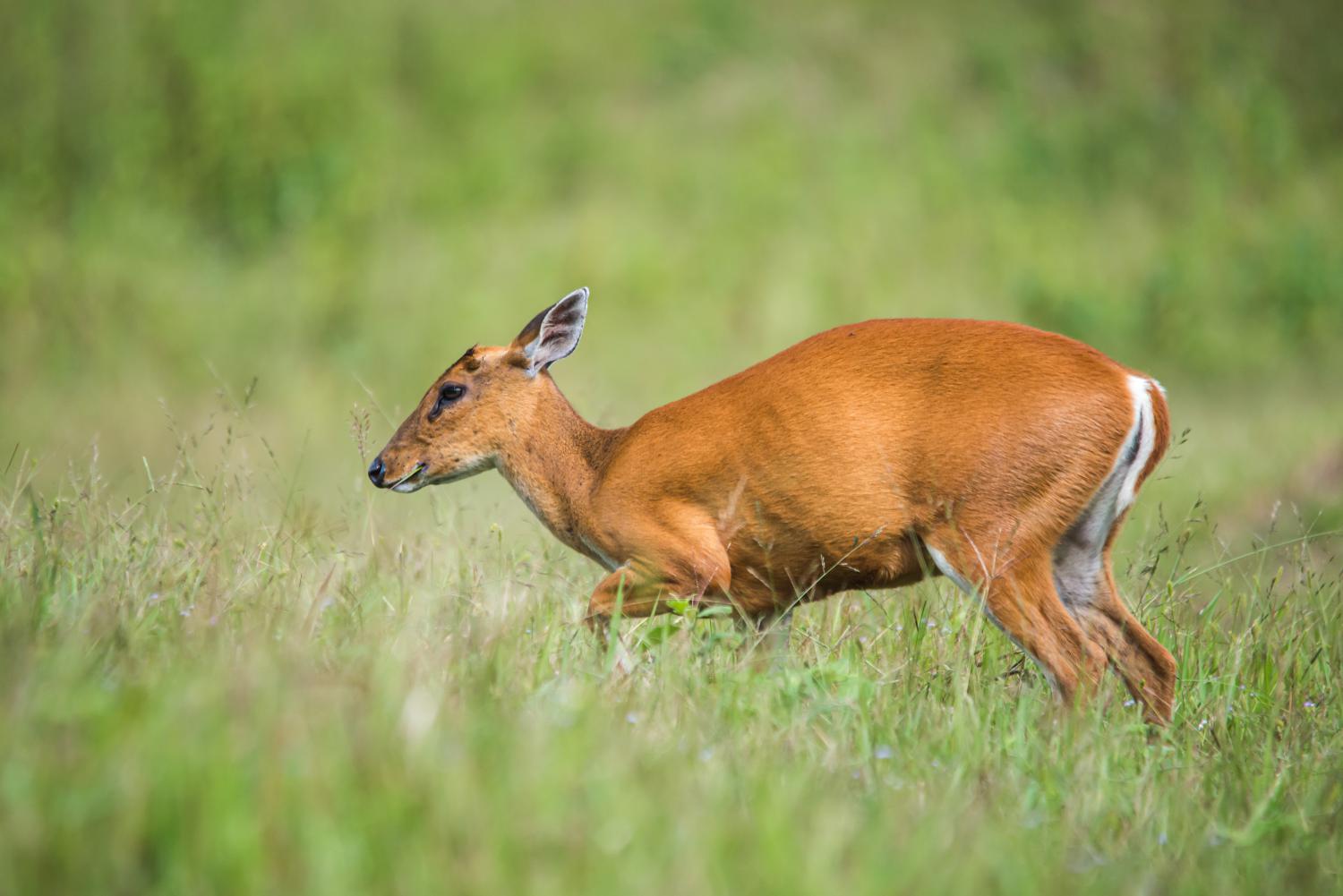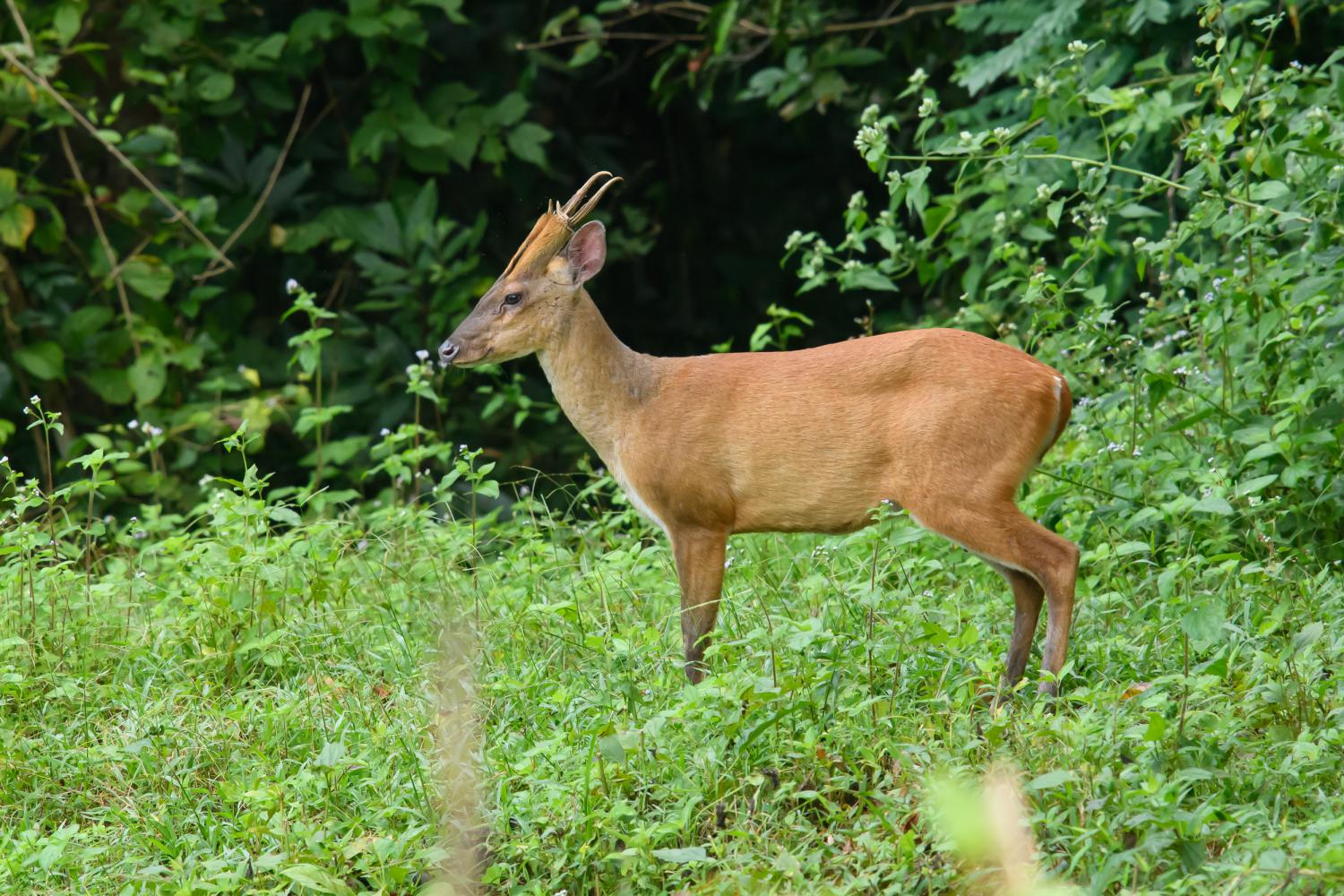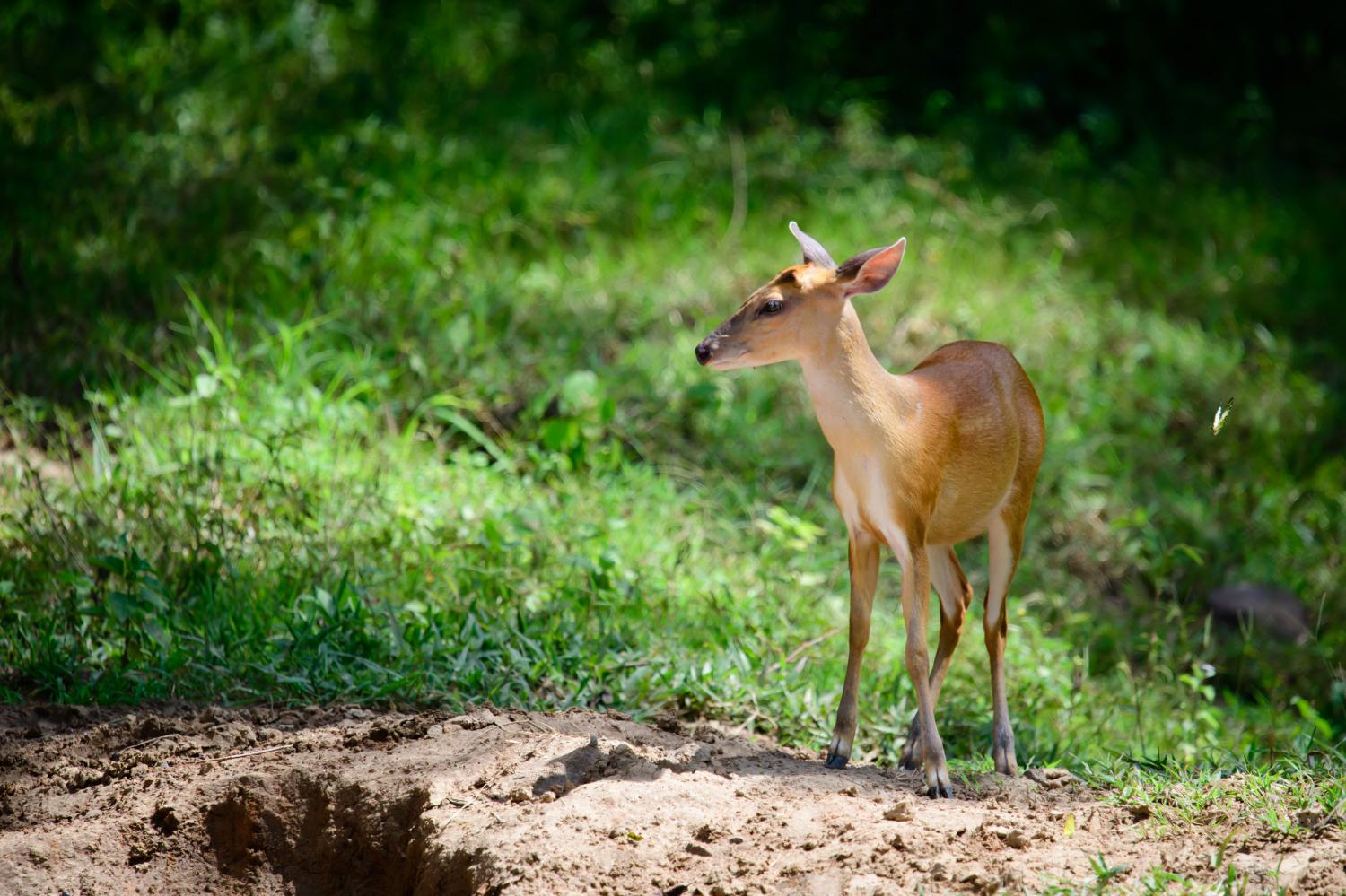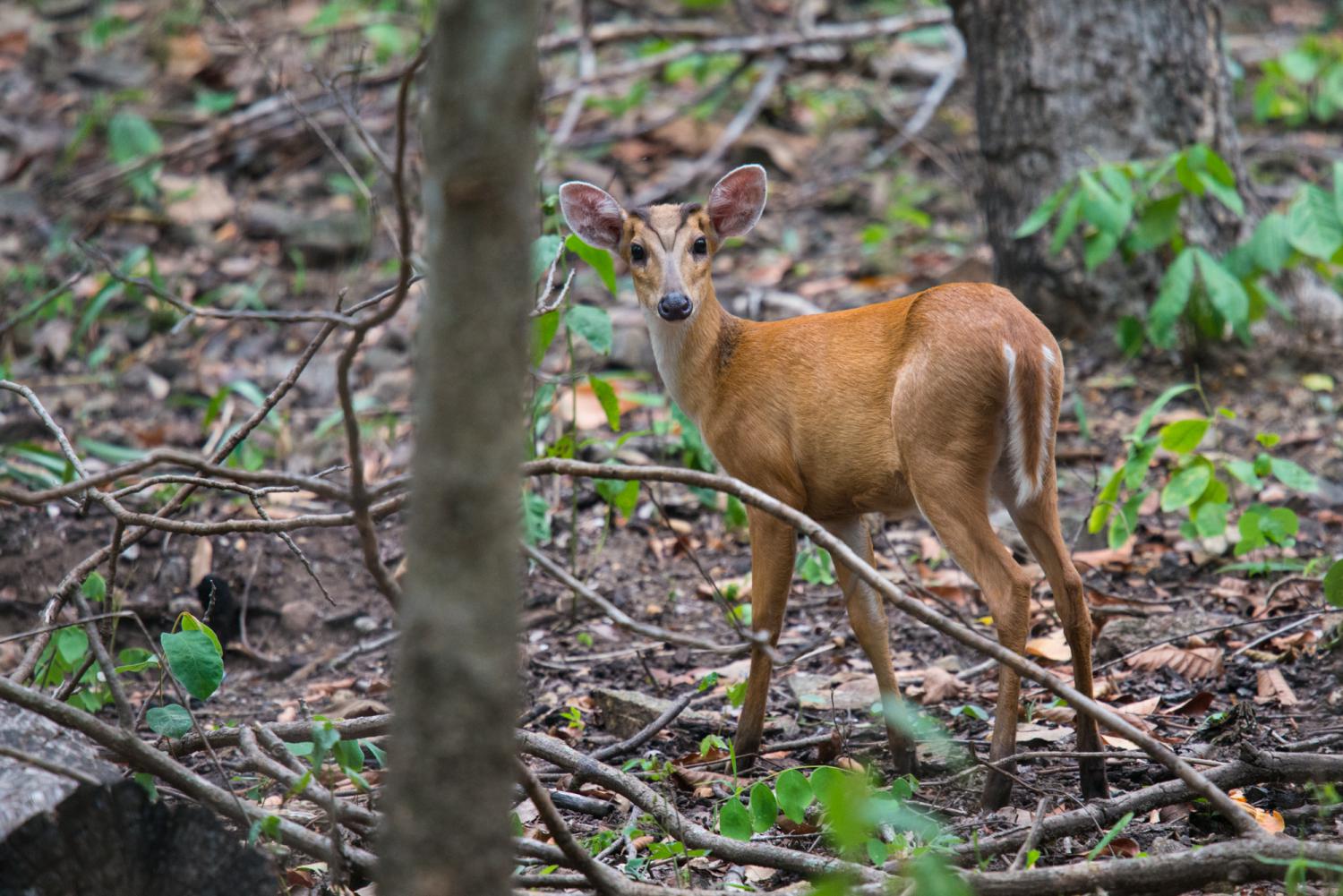Species of Thailand
Barking deer
Muntiacus muntjak
(Eberhard August Wilhelm von Zimmermann, 1780)
In Thai: เก้ง
The Indian muntjac (Muntiacus muntjak), also called the red muntjac, common muntjac or barking deer, is the most numerous muntjac deer species. It has soft, short, brownish or greyish hair, sometimes with creamy markings. This species is omnivorous, feeding on grass, fruits, shoots, seeds, birds' eggs as well as small animals. It sometimes displays even scavenging behavior, feeding on carrion. It gives calls similar to barking, usually upon sensing a predator (hence the common name for all muntjacs of barking deer).
The male Indian muntjac has small, unbranched antlers which grow to about 15 cm sp=us in length. The antlers grow annually from a bony stalk on the top of the head. Males are extremely territorial and—despite their diminutive size—can be quite fierce. They will fight each other for territory using their antlers or their (more dangerous) tusk-like upper canine teeth, and can even defend themselves against certain predators such as dogs.
Introduction
The Indian muntjac (Muntiacus muntjak) is also commonly called the "barking deer" due to the bark-like sound that it makes as an alarm when danger is present. It is also called "Kakar". Sometimes these deer will bark for an hour or more. This species is one of eleven different species of muntjacs spread across Asia. The Indian muntjacs specifically are widespread throughout Southern Asia, but are one of the least known Asian animals. Paleontological evidence proves that Indian muntjacs have been around since the late Pleistocene epoch at least 12, 000 years ago. Since then, they have played a major role in Southern Asia, being hunted for sport as well as for their meat and skin. Often these animals are hunted around the outskirts of agricultural areas as they are considered a nuisance for damaging crops and ripping bark from trees. However, this animal is still in an abundance in Southern Asia, numbering anywhere from 140, 000-150, 000 in India alone as of 2004.
Description
The Indian muntjac has a short but very soft, thick, dense coat, especially those living in cooler regions. Coloration of the coat changes from dark brown to yellowish and grayish brown depending on the season. The muntjacs' coat is golden tan on the dorsal side and white on the ventral side of the body, the limbs are dark brown to reddish brown, and the face is dark brown. However, the ears have very little hair which barely covers them. Male muntjacs have antlers that are very short, about 1-2 inches, usually consisting of only two or three points at the most and protrude from long body hair covered pedicels on the forehead. Females have tufts of fur and small bony knobs where the antlers are located in males. Males also have slightly elongated upper canines about an inch long that curve slightly outward from the lips and have the capability to inflict serious injury upon other animals or to other members of the population while exhibiting aggression. Males are generally larger than females. The body length of muntjacs varies from 35-53 in long and their height ranges from 15-26 in tall.
Habitat
The Indian muntjac is among the most widespread but least known of all mammals in South Asia. It is found in Bangladesh, southern China, northeastern India, Sri Lanka, Nepal, Pakistan, Cambodia, Vietnam, the Malay Peninsula, the Riau Archipelago, Sumatra, Bangka Island, Belitung, Java, Bali, and Borneo. This species is most densely located in Southeast Asia.
The Indian muntjac is found in tropical and subtropical deciduous forests, grasslands, savannas, and scrub forests, as well as in the hilly country on the slopes of the Himalayas. They are found at altitudes ranging from sea level up to 3000 m sp=us. They never wander far from water. Also, males usually have their own territory, which may overlap the territories of a few females but not of another male.
Diet
The Indian muntjacs are classified as omnivores. They are considered both browsers and grazers with a diet consisting of grasses, ivy, prickly bushes, low growing leaves, bark, twigs, herbs, fruit, sprouts, seeds, tender shoots, bird eggs and small warm-blooded animals. Indian muntjacs are typically found feeding at the edge of the forest or in abandoned clearings. The muntjac’s found in the Nilgiri-Wayand area of south India are always sited in the large tea estates, as they feed mostly the tea seeds. Their large canine teeth help in the processes of retrieving and ingesting food.
Reproduction
The Indian muntjacs are polygamous animals. Females sexually mature during their first to second year of life. These females are polyestrous, with each cycle lasting about 14 to 21 days and an estrus lasting for 2 days. The gestation period is six to seven months and they usually bear one offspring at a time but sometimes produce twins. Females usually give birth in dense growth so that they are hidden from the rest of the herd and predators. The young leaves its mother after about six months to establish its own territory. Males often fight between one another for possession of a harem of females. Indian muntjacs are distinguished from other even-toed ungulates in showing no evidence of a specific breeding season within the species.
Behavior
Other than during the rut (mating season) and for the first six months after giving birth, the adult Indian muntjac is a solitary animal. Adult males in particular are well spaced and marking grass and bushes with secretions from their preorbital glands appears to be involved in the acquisition and maintenance of territory. Males acquire territories that they mark with scent markers by rubbing their preorbital glands (located on their face, just below the eyes) on the ground and on trees, scraping their hooves against the ground, and scraping the bark of trees with their lower incisors. These scent markers allow other muntjacs to know whether a territory is occupied or not. Males will often fight with each other over these territories, sufficient vegetation, and for primary preference over females when mating using their short antlers and an even more dangerous weapon, their canines. If a male is not strong enough to acquire his own territory he will most likely become prey to a leopard or some other predator. During the time of the rut, territorial lines are temporarily disregarded and overlap while males roam constantly in search of a receptive female.
These deer are highly alert creatures. When put into a stressful situation or if a predator is sensed, muntjacs will begin making a bark-like sound. Barking was originally thought of as a means of communication between the deer during mating season as well as an alert. However, in more recent studies it has been identified as a mechanism used solely in alarming situations meant to cause a predator to realize that it has been detected and move elsewhere or to reveal itself. The barking mechanism is used more frequently when visibility is reduced and can last for over an hour regarding one incident.
Muntjacs exhibit both diurnality and nocturnality.
Genetics
The female Indian muntjac deer is the mammal with the lowest recorded diploid number of chromosomes, where 2n = 6. The male has a diploid number of 7 chromosomes. The similar Reeves's Muntjac (Muntiacus reevesi), in comparison, has a diploid number of 46 chromosomes.
Conservation status
Not threatened.
This article uses material from Wikipedia released under the Creative Commons Attribution-Share-Alike Licence 3.0. Eventual photos shown in this page may or may not be from Wikipedia, please see the license details for photos in photo by-lines.
Scientific classification
- Kingdom
- Animalia
- Phylum
- Chordata
- Class
- Mammalia
- Order
- Artiodactyla
- Family
- Cervidae
- Genus
- Muntiacus
- Species
- Muntiacus muntjak
Common names
- German: Indischer Muntjak
- English:
- Sundaic red muntjak
- Barking deer
- Indian muntjac
- Common muntjac
- Bornean red muntjac
- Red muntjac
- Southern red muntjac
- Sundaland red muntjac
- Spanish:
- Muntíaco de la India
- Muntíaco común
- French:
- Muntjac indien
- Cerf aboyeur
- Italian: Muntjak della Sonda
- Dutch:
- Indische muntjak
- het blaffend hert
- Russian: Индийский мунтжак
- Swedish: Indisk muntjak
- Thai:
- เก้ง
- อีเก้ง
Subspecies
Muntiacus muntjak annamensis, Cecil Boden Kloss, 1928
Range: Indochina
Muntiacus muntjak aureus, Charles Hamilton Smith, 1826
Range: Peninsular India
Muntiacus muntjak bancanus, Marcus Ward Lyon, Jr., 1907
Range: Belitung and Bangka islands
Muntiacus muntjak curvostylis, John Edward Gray, 1872
Range: Thailand
Muntiacus muntjak grandicornis, Richard Lydekker, 1904
Common name: Burmese muntjac
Range: Burma
Muntiacus muntjak malabaricus, Richard Lydekker, 1915
Range: South India and Sri Lanka
Muntiacus muntjak montanus, Herbert Christopher Robinson & Cecil Boden Kloss, 1918
Common name: Mountain muntjac
Range: Sumatra
Muntiacus muntjak muntjak, Eberhard August Wilhelm von Zimmermann, 1780
Common name: Javan muntjac
Range: Java and south Sumatra
Muntiacus muntjak nainggolani, Henri Jacob Victor Sody, 1932
Range: Bali and Lombok Islands
Muntiacus muntjak nigripes, Glover Morrill Allen, 1930
Common name: Black-footed, black-legged muntjac
Range: Vietnam and Hainan Island
Muntiacus muntjak peninsulae, Richard Lydekker, 1915
Range: Malaysia
Muntiacus muntjak pleicharicus, Jacob Herman Frederik Kohlbrugge, 1896
Range: South Borneo
Muntiacus muntjak robinsoni, Richard Lydekker, 1915
Range: Bintan Island and Lingga Islands
Muntiacus muntjak rubidus, Marcus Ward Lyon, Jr., 1911
Range: North Borneo
Muntiacus muntjak vaginalis, Pieter Boddaert, 1785
Common name: Northern Red Muntjac
Range: Burma, Thailand (Khao Yai) to Southwest China
Synonyms
- Muntiacus rubidus, Marcus Ward Lyon, Jr. (1911)
- Muntiacus bancanus, Marcus Ward Lyon, Jr. (1906)
- Cervus pleiharicus, Jacob Herman Frederik Kohlbrugge (1896)
- Cervus moschatus, Henri Marie Ducrotay de Blainville (1816)
- Cervus muntjak, Eberhard August Wilhelm von Zimmermann (1780)
Conservation status

Least Concern (IUCN3.1)
Photos
Please help us review our species pages if wrong photos are used or any other details in the page is wrong. We can be reached via our contact us page.
Range Map
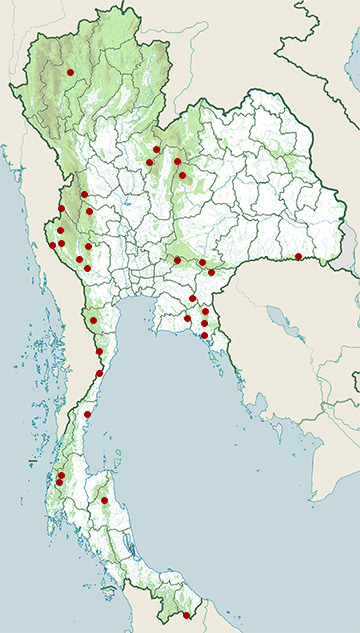
- Chaloem Rattanakosin National Park
- Doi Suthep - Pui National Park
- Erawan National Park
- Hala-Bala Wildlife Sanctuary
- Huai Kha Khaeng Wildlife Sanctuary
- Huai Yang Waterfall National Park
- Kaeng Krachan National Park
- Khao Ang Rue Nai Wildlife Sanctuary
- Khao Chamao - Khao Wong National Park
- Khao Dinsor (Chumphon Raptor Center)
- Khao Khitchakut National Park
- Khao Laem National Park
- Khao Luang National Park
- Khao Sam Roi Yot National Park
- Khao Soi Dao Wildlife Sanctuary
- Khao Sok National Park
- Khao Yai National Park
- Khlong Saeng Wildlife Sanctuary
- Kui Buri National Park
- Mae Wong National Park
- Nam Nao National Park
- Namtok Phlio National Park
- Pang Sida National Park
- Phanom Dong Rak Wildlife Sanctuary
- Phu Hin Rong Kla National Park
- Phu Khiao Wildlife Sanctuary
- Salak Pra Wildlife Sanctuary
- Thap Lan National Park
- Thong Pha Phum District, Kanchanaburi
- Thong Pha Phum National Park
- Thung Salaeng Luang National Park
- Thung Yai Naresuan Wildlife Sanctuary
